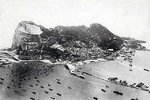Freebird
Master Sergeant
Assuming that you meant something like this, there are alot of problems with this scenario
How do they manage to bomb Gibraltar? There are very few Axis ultra-long range bombers, and it is about 900 - 1000 miles each way over water from Marseille south france. It is only about 600 miles from Bayonne in France, but this would involve violating Spanish neutrality. IIRC the range of a Ju88 is about 1300 miles?
In any event, there would be no escorting fighters, so the Axis bombers would be savaged by intercepting British night fighters, and Gibraltar was well equipped with Flak
All ships were searched by the RN blocade, and certainly not allowed to dock at Gibraltar. an unidentified ship attempting to dock would be fired on
Again, unidentified aircraft were not allowed to land, an aircraft in distress would be directed to Cadiz
I'm not sure how feasable this would be? But certainly would not blind gunners on the seaward side of Gibraltar.
As Parsifal has pointed out, the runway contained no cover, and was directly under the guns of the fortress, any troops in transport aircraft would be slaughtered. Besides, how many troops can you fit in a Ju52 for example?
Paratroops Gliders landing on the runway would be wiped out by the guns. Are you suggesting that the paratroopers try to land on the rocky slopes?
How many troops can you land by U-boat? 300? 500? vs 20,000+ defenders?
They would still be unable to neutralize the seaward side fortress guns, which would have a field day with approaching cargo ships.
Where would these cargo ships come from, Germany or Italy?
-------------------------
But I'm willing to be an armchair general and take a whack at it.
The axis powers for 2 straight weeks day and night use incendiaries and heavy ordinance to bomb Gb to try and deprive the defenders of sleep.
How do they manage to bomb Gibraltar? There are very few Axis ultra-long range bombers, and it is about 900 - 1000 miles each way over water from Marseille south france. It is only about 600 miles from Bayonne in France, but this would involve violating Spanish neutrality. IIRC the range of a Ju88 is about 1300 miles?
In any event, there would be no escorting fighters, so the Axis bombers would be savaged by intercepting British night fighters, and Gibraltar was well equipped with Flak
On the final day a German captured allied ship filled with fuel docks in the main harbor.
All ships were searched by the RN blocade, and certainly not allowed to dock at Gibraltar. an unidentified ship attempting to dock would be fired on
A few hours later at dusk an emergency message is sent from 2 twin-engine cargo aircraft that they are under attack and need to make an emergency landing – one of them visibly has an engine on fire. They are Jewish scientists (or somebody else) who have escaped with their wives and families from Vichy France. Pursuers turn around and the aircraft land on the runway. Out step German soldiers discussed as women and old men.
Again, unidentified aircraft were not allowed to land, an aircraft in distress would be directed to Cadiz
At that point, the "allied ship" is detonated and either explodes or at least burns fiercely hopefully blinding AA gunners and lighting the way for the Germans. Soldiers from the 2 cargo aircraft pour out and secure the airport/runway.
I'm not sure how feasable this would be? But certainly would not blind gunners on the seaward side of Gibraltar.
As Parsifal has pointed out, the runway contained no cover, and was directly under the guns of the fortress, any troops in transport aircraft would be slaughtered. Besides, how many troops can you fit in a Ju52 for example?
Paratroopers start to land and reinforce the troops already there (I've seen Gb and I do think it's possible to land paratroopers there). Then Gliders proceed to land.
Paratroops Gliders landing on the runway would be wiped out by the guns. Are you suggesting that the paratroopers try to land on the rocky slopes?
What's left of the harbor is now secured. Additional troops are landed via cargo U-Boats filled with men and equipment.
How many troops can you land by U-boat? 300? 500? vs 20,000+ defenders?
The main German troop ships that were waiting nearby in Spanish harbors disguised as neutrals now set sail and arrive within a half hour.
They would still be unable to neutralize the seaward side fortress guns, which would have a field day with approaching cargo ships.
Where would these cargo ships come from, Germany or Italy?







